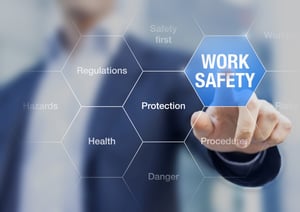
Fall Protection
We are often asked about the fall protection requirements for installing wired guardrail systems on constructions sites.
As a general matter, each worker on a walking or working surface 6 feet or more above a lower level must be protected from falling by a guardrail system, a safety net system, or a personal fall arrest system. §1926.501(b)(15)
The standard also states that each worker on walking or working surfaces must be protected from falling through holes (including skylights) that are more than 6 feet above lower levels, by personal fall arrest systems, covers, or guardrail systems erected around such holes. §1926.501(b)(4)(i)
Further, each worker on a walking or working surface must be protected from tripping in or stepping into or through holes (including skylights) by covers. §1926.501(b)(4)(ii)
Fall Protection Plan
As a general matter, OSHA presumes that using conventional fall protection (e.g. guardrails, personal fall arrest systems, or safety nets) is feasible and will not create a greater hazard to use. However, there are a few circumstances when an employer can use a site-specific fall protection plan instead of conventional fall protection. (OSHA 3146)
Instead of!? Why not compromise and do both – shall we? Your project has moved into the phase where employees are going to be working at heights of 6 feet or more. Working at such heights equals “fall protection required” in the construction industry. Surely, we can all agree that the installers of fall protection deserve fall protection themselves.
Your fall protection plan should include, but not be limited to:
- Fall hazards in the work area,
- Method(s) of fall arrest or restraint,
- Assembly and disassembly instructions for any equipment,
- Handling, storage and securing of material and tools,
- Overhead protection,
- Injured worker response,
- Training program.
Your fall protection plan:
- Must be prepared by a qualified person,
- Must be maintained and kept up to date,
- Must have changes approved by a qualified person.
Using an Aerial Lift
Aerial lifts have replaced ladders and scaffolding on many job sites due to their mobility and flexibility, although many workers are injured or killed on aerial lifts each year.
Are aerial lifts hazardous? Yes. Will the use of an aerial lift cause additional planning and training? Yes. Could aerial lifts provide effective fall protection when installing wired guardrail systems on construction sites? Yes.
If you are installing a guardrail system, then chances are high one does not already exist. So, you have an unprotected edge on your hands. If you are installing the same guardrail system working from an aerial lift, then the task at hand becomes less hazardous. However, working from an aerial lift comes with its own unique hazards and fall protection and operation requirements:
Hazards
Fall from elevated level,Tip-overs,
Electric shock (Electrocutions).
Fall Protection Requirements
Use a body harness or a restraining belt with a lanyard attached to the bucket,
Ensure that access gates or openings are closed.
Operation Requirements
Perform pre-start inspection and work zone inspections,
Do not exceed the load-capacity limits; vertical or horizontal reach limits.
Safety [Training] Matters
When you make the decision to complete a fall protection plan and utilize aerial lifts on your job site, your efforts on ensuring the safety and health of your crew rely heavily on how well they are trained. Any employee exposed to fall hazards must be trained on fall protection, devices and hazards as well as your site-specific plan. Aerial lift operators must be trained on hazard recognition, proper operation, and any manufacturer’s requirements. Do not forget to document your training for verification purposes and remember to provide retraining for affected workers when something changes (e.g. fall protection equipment) or if you notice any inadequacies in the retention of previous training.
Elevate your safety training with the use of toolbox talks and daily morning huddles. Engagement lifts your safety conversation and arrests any chance of falling workers. Try it!
Fall Protection in Construction – OSHA 3146
Aerial Lifts – OSHA Fact Sheet

















